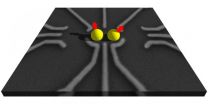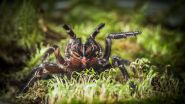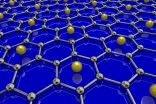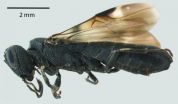(Press-News.org) Calculation with electron spins in a quantum computer assumes that the spin states last for a sufficient period of time. Physicists at the University of Basel and the Swiss Nanoscience Institute have now demonstrated that electron exchange in quantum dots fundamentally limits the stability of this information. Control of this exchange process paves the way for further progress in the coherence of the fragile quantum states. The report from the Basel-based researchers appears in the scientific journal Physical Review Letters.
The basic idea of a quantum computer is to replace the ones and zeros used in today's bits with quantum states, or qubits. Qubits are units of information that not only assume the values zero and one, but in which zero and one are possible at the same time, and in any chosen combination, in the form of a quantum superposition. Qubits can, for example, be implemented using the spins of individual electrons held in nanoscale structures made of semiconducting material, known as quantum dots. By exploiting quantum-mechanical principles such as superposition, a quantum computer can achieve enormous processing speeds - but only if the electron spins persist for long enough.
In recent years, it has been possible to extend this so-called coherence time to over a millisecond, thanks to the successful reduction of interference caused by nuclear spins. Thus, the search for other factors that affect the stability of the electron spins increased in importance.
Discovery of electron exchange
Physicists at the University of Basel and the Swiss Nanoscience Institute have now established that qubits' coherence is limited by a process in which individual electrons are exchanged between a quantum dot and an external reservoir. The reservoir represents a type of electrode that is in contact with the quantum dot and is required for the measurements.
The researchers, led by Professor Dominik Zumbühl, observed that thermal excitation prompts an electron to jump from the quantum dot into the reservoir, and that shortly thereafter an electron jumps from the reservoir into the quantum dot.
This exchange creates a short-lived charge state, which the researchers in Basel have now been able to demonstrate for the first time with a charge sensor. The exchange process also leads to a randomizing of the electron spins, through which quantum information is lost.
Fundamental process for coherence
Based on the experimental observations, the researchers were able to significantly extend the existing theoretical description of double quantum dots, which can contain two electrons. They also succeeded in influencing the intensity of the temperature-dependent exchange process by cooling the electrons down to 60 millikelvins. At the same time, the process was slowed and the stability of the spins prolonged by changing the voltages at the entrances, or gates, to the quantum dot.
An understanding and control of this exchange process, which is fundamental to quantum dots, paves the way for further progress in qubit coherence. At the same time, it opens the way to a quick generation of desired spin states in quantum dots.
Implementation of a theoretical concept with Basel roots
This approach, whereby quantum dots in semiconductors are exploited in order to use the spin of an individual electron as a qubit, can be traced back to Prof. Daniel Loss of the University of Basel and the American physicist David DiVincenzo. Their concept, which they originally presented in 1998, has the potential to allow the creation of quantum computers with a large number of connected spin qubits. The current study was carried out in collaboration with researchers from the University of St Andrews (GB) and the University of California, Santa Barbara (US).
INFORMATION:
DENVER, Colo. -- The International Association for the Study of Lung Cancer (IASLC) today issued a new statement on Tobacco Control and Smoking Cessation at the 16th World Conference on Lung Cancer (WCLC) in Denver. The statement calls for higher taxes on tobacco products, comprehensive advertising and promotion bans of all tobacco products and product regulation including pack warnings.
"Tax policies that increased the cost of cigarettes have played a prominent role in the reduction of cigarette smoking," said Dr. Kenneth Michael Cummings, Professor, Hollings Cancer ...
Scientists studying funnel-web spiders at Booderee National Park near Jervis Bay on the New South Wales south coast have found a large example of an unexpected funnel-web species.
The scientists believe the 50-millimetre spider is a species of the tree-dwelling genus Hadronyche, not the ground-dwelling genus Atrax, which includes the Sydney funnel-web, the only species reported in the Park's records.
"It's remarkable that we have found this other species in Booderee National Park," said Dr Thomas Wallenius, from The Australian National University (ANU).
"It shows ...
Graphene, the ultra-thin, ultra-strong material made from a single layer of carbon atoms, just got a little more extreme. University of British Columbia (UBC) physicists have been able to create the first ever superconducting graphene sample by coating it with lithium atoms.
Although superconductivity has already been observed in intercalated bulk graphite--three-dimensional crystals layered with alkali metal atoms, based on the graphite used in pencils--inducing superconductivity in single-layer graphene has until now eluded scientists.
"This first experimental realization ...
Social network Flickr and citizen science website BugGuide have helped scientists to expand the known range of a rarely collected parasitic woodwasp, native to the eastern United States. Partially thanks to the two online photograph platforms, now the species' distribution now stretches hundreds of miles west of previous records. Previously known from only 50 specimens mainly from the Northeast, now the species was discovered in the Ozark Mountains by researchers from the University of Arkansas. Their study is published it in the open access journal Biodiversity Data Journal.
Spurred ...
[Basel, Switzerland - 8 September 2015] The Drugs for Neglected Diseases initiative (DNDi) has announced today at the 9th European Congress on Tropical Medicine and International Health (ECTMIH) in Basel, Switzerland, the successful completion of Phase I human clinical trials for SCYX-7158 (AN5568), the first oral drug candidate specifically developed from the earliest drug discovery stage to combat human African trypanosomiasis, or sleeping sickness, a deadly parasitic disease transmitted by the tsetse fly.
The Phase I study, conducted in France, assessed the safety, ...
Edible dormice (Glis glis) spend about eight months on average in hibernation. Wildlife biologists from the Research Institute of Wildlife Ecology of the Vetmeduni Vienna have shown for the first time that these animals can hibernate for up to 11.4 months. "This may be a world record," says Claudia Bieber, co-author of the study. "Dormice in our climate zone don't just spend the winter months underground, they sometimes begin hibernating in summer."
The animals do not hibernate for so long every year, but only in years when beech trees produce few beechnuts. Successful ...
In the new study 'Building trust: Heart rate synchrony and arousal during joint action increased by public goods game' (Journal of Physiology and Behavior) PhD and assistant professor Panagiotis Mitkidis and colleagues from the Interacting Minds Centre at Aarhus University studied the link between heart rate and trust. They had 37 pairs of participants do a cooperative task involving building LEGO cars. The control group only did the LEGO task, while a second group played an investment game in between the building sessions. The game, known as the 'Public Goods Game', had ...
Select patients age 90 years and older with aortic stenosis (AS) can benefit from a relatively new, minimally invasive surgery for aortic valve replacement, according to an article in the September 2015 issue of the Annals of Thoracic Surgery.
Key points
Both transfemoral and transapical approaches to TAVR appear to be safe and effective for treatment of aortic stenosis in select patients age 90 years and older.
By 6 months post-surgery, most quality-of-life measures had stabilized at a level considerably better than baseline, meaning patients quality of life was ...
Lueneburg. A recent study on the psychology of trademarks shows that they are perceived by the same psychological mechanisms as those, which enable the recognition of faces. The survey, whose result is particularly interesting for the advertising industry and brand management, originated at the Institute for Experimental Business Psychology at Leuphana University of Lueneburg.
For their investigation, Leuphana researchers Rainer Hoeger and Anne Lange compared the reactions of viewers to 16 well-known brands, such as Coca Cola, Rolex, Porsche or Apple and 18 computer-generated ...
Trained volunteers are as good as professional astronomers at finding jets shooting from massive black holes and matching them to their host galaxies, research suggests.
Scientists working on citizen science project Radio Galaxy Zoo developed an online tutorial to teach volunteers how to spot black holes and other objects that emit large amounts of energy through radio waves.
Through the project, volunteers are given telescope images taken in both the radio and infrared part of the electromagnetic spectrum and asked to compare the pictures and match the "radio source" ...




